Abstract
This study investigates the integration of assisted natural regeneration (ANR) and selective logging (SL) to guarantee a sustainable forest operation in the Philippines using agent-based modeling. To assess the sustainability of the operation in light of the revenue from timber harvesting and the health of the forest in terms of the total number of trees, various simulations were run on a theoretical forest modeled after the Mount Makiling Forest Reserve in the Philippines. The findings of the simulation have shown that, even after many years of continuous use, the performance of SL on a healthy forest similar to the theoretical forest is substantially identical with and without ANR. The “with ANR” setup, however, was able to demonstrate a considerably better and more stable harvest value over the final 100 years than the “without ANR” setup. In terms of ensuring sustainable forest cover, simulation findings showed that even after 500 years of continuous SL activity, the forest cover could be maintained to up to 80% with ANR. The model has shown that with the right combination of reforestation efforts and timber harvesting methods, a sustainable forest operation can contribute to the country’s economic needs for timber production while ensuring that the forest is actively managed.
1. Introduction
The Philippines was colonized by the Spaniards way back in 1521 and the country then had about 27 million hectares, or 90% of the country, still covered with forests [1,2]. However, in 1934, the forest cover declined to about 57% and in 2003, the country’s remaining forests further dropped to only about 24%. In 2010, the forest cover in the country was estimated by the National Mapping and Resource Information Authority (NAMRIA) to be around 24% only and this accounts for about 6.84M ha of forests [3]. However, with the passing of the National Greening Program in 2011 through Executive Order No. 26 which aims to plant 1.5B trees in 1.5M ha from 2011 to 2016, the country’s forest in 2015 increased to 7.01M ha [3]. The country has observed further forest gain with the last 2020 statistics on Philippine forests, which are currently estimated to be around 7.23M ha [3]. Despite this optimistic increase, the country’s forest cover is still lagging behind the global average of 30% [4].
Forests provide one of the most important renewable natural resources, wood. The Philippines requires 6 million cubic meters (m3) of wood annually, based on its 2006–2014 average wood consumption [5]. However, due to years of unsustainable forest practices, various policies were enacted in the country that restricted timber harvesting starting in the late 1980s, culminating in Executive Order No. 23 in 2011 (EO 23) [6]. This moratorium imposed a total ban on the cutting and harvesting of timber in natural and residual forests nationwide. These government bans on forest operations have led to a serious shortage of local wood supply, with local sources able to provide only 25% of wood demand while the rest are sourced through imports [5]. Thus, there is a need for intensive quantitative and qualitative impact analyses of these policies to determine whether they should be continued, amended, or abolished [7].
Due to the inherent complexities in the dynamics of forest growth, coupled with the need to assess the long-term effects of forest management regimes, models have become a crucial component in many forest planning processes [8]. One of the most recent efforts to assess multiple forest management regimes is described in the paper “Forest Conservation in the Philippines: An Economic Assessment of Selected Policy Responses Using a Computable General Equilibrium (CGE) Model” by Stenberg and Siriwardana [9]. A CGE model was used to investigate the economic impact of four policies (i.e., selective logging, stumpage tax, forestry discount rates, and set-aside areas) described in the Master Plan for Forestry Development that was implemented in the Philippines from 1991 to 2015. Simulation results showed that economic growth that enables forest conservation is possible with the combination of selective logging and set-aside areas. However, the study was limited to a small open economy with an equation-based forestry submodel that uses 1998 Philippine data.
With the improvements in geographic information systems (GIS) and remote sensing, abundant data on forests have been made available. Simulation models coupled with GIS provide a more site-specific and up-to-date analysis of forest status and the impact of management regimes. Thus, there is a need for a simulation model using GIS data that can assess different policies and determine how each, or a combination of them, can contribute to sustainable forestry.
1.1. Agent-Based Modeling
Advances in modeling led to the development of methodologies for policy modeling that can capture multiple crucial interactions, describe mechanisms and processes, and provide likely trajectories [10]. One of the most extensively used methodologies to describe policies and understand forest growth dynamics is the agent-based modeling (ABM) approach. ABMs are developed to model autonomous decision-making entities, called agents, interacting in a virtual environment [11]. In policy analysis, good ABMs come as a natural tool where policy analysts and decision-makers can explore potential macro-effects of different policy interventions as an ex-situ experimentation of a real-world setup [12]. Furthermore, ABM is also considered a powerful simulation tool that can capture the behavior and interaction of diverse components in a complex socioeconomic system (SES) [13]. More advanced ABM tools can also provide support for building spatially explicit simulations based on GIS data and executing large-scale simulations that can better describe SES [14]. The relevance of ABM in modeling forest resource management has been demonstrated through previous case studies [15,16].
In this light, this paper presents a first attempt to utilize the ABM approach to model forest growth and test forest management regimes that aim to promote sustainable timber harvesting in the context of the Philippines. We describe an ABM of a sustainable forest operation (hereafter referred to as GIS agent-based modeling architecture or GAMA Forest Model) on a theoretical forest that was created using data based on an actual forest inventory conducted in the Philippines.
1.2. Forest Management Regimes
Typical forest management activities involve stand regeneration, timber harvesting, and silviculture, with many forest resource management objectives being achieved through active timber resource management [17]. Among the different timber harvesting strategies, there is a general view that selective logging (SL) is widely implemented and crucial to the economy [18]. SL is the removal of selected trees in the stand that are more economically valuable. In the context of ecosystem multifunctionality, with one of the variables being wood production, it has been determined that SL is a good management technique [19]. However, recent studies have emerged questioning the sustainability of SL [20].
On the other hand, forest regeneration activities can be classified into two: natural regeneration and active restoration. There is an inverse relationship in terms of economic potential and biodiversity benefits between the two, with natural regeneration being more beneficial to the biodiversity of the forest but with less economic potential. In contrast, active restoration is the opposite [21]. Between the two extremes lies assisted natural regeneration (ANR), a mix of active planning and passive restoration. The goal of ANR is to restore denuded forests by following and enhancing the natural ecological succession [22]. Pioneer species are let to grow or assisted to out-compete gap species such as grass and prepare the environment for higher forms of vegetation, i.e., climax species. ANR typically involves the use of indigenous species, thus helping restore biodiversity and ecological functions of the ecosystem. Forests restored with ANR are known to be more biologically diverse than those that are regenerated in conventional methods. Compared with active restoration methods, ANR entails significantly lower costs [17]. The formal concept of ANR emerged in the Philippines in the 1980s and has since been at the forefront of reforestation in the country [23].
The combination of these management choices (SL and ANR) has been applied within the context of Indonesian selective cutting and planting (TPTI). However, there has been very little success for many reasons, one being that the concept of ANR is unfamiliar to Indonesian foresters due to insufficient publications on the subject [24]. In terms of the application of the combination in the Philippines, there has not been any recent project that implemented it. Thus, we have created a model focusing on the combination of SL for timber harvesting and ANR for reforestation to test whether the combination can promote a sustainable forest operation.
2. Materials and Methods
2.1. Model Description
We used the ODD (overview, design concepts, and details) protocol [25,26] to describe the model.
2.1.1. Overview
An agent-based model was developed to explore how ANR with SL can contribute to sustainable forest resource management. The model was created inside GAMA 1.8.1, a platform that seamlessly integrates GIS data to create data-driven, agent-based models [14]. The GAMA Forest Model simulates the growth of a theoretical forest such that one simulation step is equivalent to one year. The model is a simplified forest containing multiple species classified as either premium or nonpremium. The complete list of species that are considered premium is shown in Table A1 in Appendix A. The theoretical forest also includes rivers, roads, and protected areas (the portion of land where there is a river crossing). Trees inside the forest are administered by parcels, such that harvesting and planting are conducted per parcel and managed by a regime. The details of all the entities considered in the model are given below.
Entities
Trees: A single tree stand is described using the following attributes: basal area (BA), height (H), volume (V), and diameter-at-breast-height (DBH). BA is the common term used to describe the average area occupied by tree stems, which is a useful index for making timber harvest decisions. A tree’s annual growth is characterized by the increment in the values of its attributes (Table 1).

Table 1.
Equations used for tree growth.
Parcels: The abstract landscape is a spatial grid of 256 parcels (16 × 16). Each parcel agent determines the harvestability of the parcel and computes the parcel’s total BA and harvests profit on each simulation step. A parcel’s harvestability depends on the total harvestable volume, which is the sum volume of all harvestable trees inside the parcel (a harvestable tree is a tree with DBH above the minimum harvestable requirement). The harvest profit (HP) (in Philippine peso (PHP).) of a parcel is computed using the tree volume equations (see Table 1) and the average value and average cost of harvesting round logs (see Table 2).

Table 2.
Economic Parameters for Timber Harvesting (2019).
Equation (1) describes how HP is computed given the following parameters:
The equation for computing HP is given below.
where
Moreover, tree senescence is also monitored at the parcel level. We considered that a tree has reached senescence when its DBH reaches 210 centimeters (cm) or more. At each step, all trees that have reached senescence are removed from the parcel.
Regime: Agent responsible for implementing the SL and ANR rules. The regime agent assigns parcels that satisfy the ANR and SL criteria to planter and harvester agents, respectively.
To determine the candidate parcels that require replanting, the regime agent sorts them based on the total BA and its capacity to hold trees. Available planters will be assigned a parcel with the lowest total BA and the greatest capacity to hold trees. The capacity to hold trees is determined by subtracting the current number of trees on the parcel from the maximum number of trees per parcel.
On the other hand, to perform SL, the regime agent assigns harvestable parcels to available harvesters for harvesting. A parcel is considered harvestable if it is not protected and its current volume satisfies the minimum harvest volume allowed per parcel. Harvestable parcels are prioritized based on the expected harvest profit, so harvestable parcels with the highest harvest profit are assigned to available harvesters.
Harvester: Agent responsible for removing harvestable trees in a parcel. Harvesting is implemented by sorting the DBH of the trees, then assessing the protection value, and finally cutting the candidate trees. The total volume of trees allowed to be harvested is based on the DENR [32], which establishes that the harvestable volume (in m3) per hectare in the operable second-growth forest is determined based on the equation. This applies to all areas in the Philippines except Palawan and Region 8, where the percentages shall apply to the 50 cm DBH and 60 cm and over DBH, respectively. According to the FMB [30], DBH (diameter at breast height) is referred to as the average stem diameter outside bark at a point 1.3 m above the ground while DAB (diameter above buttress) is measured at 0.30 m above the highest flange or buttress.
Planter: Agent responsible for “planting” new trees on the parcel. The number of new trees that will be planted depends on the capacity of the parcel to hold trees. The new trees will be planted in random available locations in the parcel.
Process Overview and Scheduling
One simulation execution corresponds to one year and consists of seven chronologically ordered steps, as shown in Figure 1.
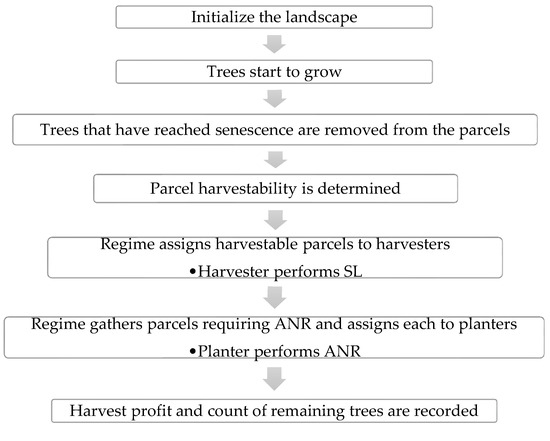
Figure 1.
Scheduling of the successive steps in a year simulated by the GAMA Forest Model.
There can be multiple harvesters and planters, while there is always one regime and 256 parcels in one execution of the model. The model was run for 500 simulation years to observe the dynamics between the harvester and planter agents. Except for the first step, the other steps are repeated chronologically until the end of a simulation experiment.
2.1.2. Design Concepts
The model’s design followed the following concepts: emergence, stochasticity, sensing, and observation.
Emergence. To establish dependence on the number of harvesters and planters, there will be an emerging harvesting pattern resulting from the ANR and SL-based decisions of the regime despite having no direct interaction between the harvester and planter agents.
Stochasticity. To simulate spatial variability, stochasticity is added to the ANR rules. The exact tree species planted is determined based on a 50% chance of planting a premium tree and a 50% chance of planting a dipterocarp. Stochasticity is added to determine what combination of trees provides a greater harvest profit and leads to more forest cover. However, the exact observation is not included in this paper.
Sensing. The regime agent is assumed to have access to the status and harvestability of all parcels to determine which are suited for SL and ANR.
Observation. A couple of observations were noted in the model, but the most important values are the total harvest profit, the number of remaining trees (forest cover), and the number of candidate parcels for SL and ANR.
2.1.3. Implementation Details
Initialization
The initial configuration of the model environment is a landscape with 256 parcels, where each parcel is a 4-ha plot of land (Figure 2a) containing a total of 336–448 tree stands (with mean = 390). The trees are distributed in the landscape based on an actual tree inventory (Figure 2b). Aside from trees, a parcel may also have rivers, roads, and protection specifications (Figure 2c).
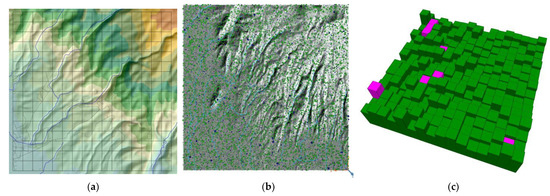
Figure 2.
Screenshots of the landscape: (a) landscape divided into parcels, (b) landscape populated with initial distribution of trees, and (c) landscape visualized with initial volume of parcels and location of protected parcels (in magenta).
To define an experiment, several variables must be set at the start of the simulation. The list of parameter variables for determining the number of agents as well as the SL and ANR rules, along with their default values and the range of permissible values, are shown in Table 3.

Table 3.
Parameters for setting a simulation experiment.
The number of harvester and planter agents in a simulation can be adjusted by changing the values of the variables under the general setup (there is no restriction on the number of agents allowed). By manipulating the values of the variables under the SL setup, it is possible to set the rules that direct the regime agent in deciding which parcels will be assigned to harvester agents (i.e., minParcelVolReqForHarvesting and minTreeDBHReqForHarvesting) and for the harvester to know how many trees can be harvested on the parcel (i.e., maxAllowedHarvestVolPerParcel). The rules that direct the regime agent in determining which parcels need to be replanted (i.e., maxTreesPerParcel) and that inform the planter of how many trees and which species to plant (i.e., maxTreesPerParcel, premChance, and dipteroChance) are updated by altering the values of the variables under the ANR setup. Additionally, it is possible to disable replanting and let the model run just on SL. This functionality was implemented so that the system may be observed using a natural regeneration setup (but this is for the next version of the model).
Input Data
Due to limitations on the use of existing data and to focus on the description of a sustainable forest operation outside the constraints of existing forest lands (such as currently imposed policies and management history), we decided to test the GAMA Forest Model on a theoretical forest that is based on an actual forest inventory. We created a 1024-hectare forest characterized by river and road networks that traverse the site diagonally from the southwest (Figure 3).

Figure 3.
Landscape of the theoretical forest patterned after Mount Makiling Forest Reserve, Philippines and used in the GAMA Forest Model.
The species composition of the theoretical forest resembles that of the lowland dipterocarp forest of Mt. Makiling in Laguna, Philippines. Thus, the most common species are Dipterocarps. A total of 99,988 tree stands are present in the theoretical forest, with a majority (66.42%) of tree individuals belonging to the ≤20 cm DBH class and 56,853 (56.8%) trees considered as premium type. Figure 4 describes the population of trees in the theoretical forest.

Figure 4.
Distribution of trees in the theoretical forest in terms of type (a) and DBH (b).
Submodels
- Selective Logging
After the regime agent has assigned a parcel to the harvester agent, the “start harvesting” and “cut trees” actions of the harvester agent are invoked. The “minDBHRequired” in the initial model configuration was set to 60 cm, according to Equation (4). The harvester agent cuts all trees in the assigned parcel with a DBH equal to or greater than 70 cm until the limit for harvesting volume has been reached. If the limit has not yet been reached, the harvester harvests 50% of the trees with DBH between 60 and 69 cm. Once the limit is reached, the DBH of all remaining trees (with a DBH ≤ 15 cm) will be increased by 2 cm as an incentive for the additional resources released by removing the largest trees in the parcel. The actual harvest profit is recalculated after the harvest is completed to account only for the harvested trees.
- Assisted Natural Regeneration
After the regime agent has determined which parcels to replant, the “start planting” action of the planter agent is invoked. ANR is executed on the parcels assigned to the planters. The total number of new trees to be planted is based on the remaining capacity of the parcel to hold trees. New trees will be planted at randomly available locations in the parcel with an initial DBH of 0.5 cm and H of 0.3 m. The species that will be planted is determined by chance based on the set probability of planting a premium tree and/or a dipterocarp.
Figure 5 shows the complete overview of the design of the GAMA Forest Model following the conceptual model approach proposed by Taillandier et al. [33]. It also describes the attributes of each agent and the connections between agents as organized inside the GAMA platform.
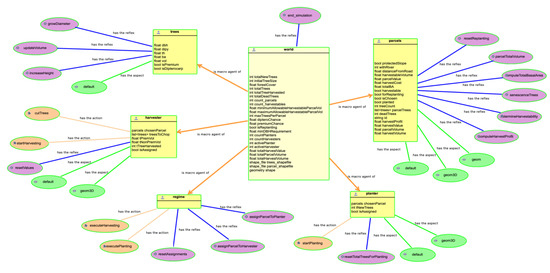
Figure 5.
Conceptualization of the GAMA Forest Model.
2.2. Economic Analysis of Timber Extraction
On the economic side, the model was analyzed using the approach adopted from Mangaoang [31], with necessary adjustments made based on the biophysical characteristics of the theoretical forest used in the study and the actual price changes of timber and timber products over time in the Philippine context. While Mangaoang [31] presented the cost and returns to producing different timber products, this study focused on round logs/flitches since the data are free from post-harvesting inefficiencies (i.e., low recovery rates) for sawn timber and wood products/furniture. This implies that the simulation assumes the efficient extraction of round logs from the theoretical forest that is valued using average market prices. Moreover, Mangaoang’s return on investment (ROI) estimate, which was equal to one (for harvesting round logs excluding transport cost), seems to be more realistic and economically viable than for the other timber products, and thus was used as the basis for the economic decision to harvest. To mirror, at scale, the values estimated by Mangaoang for community-based timber harvesting activity for round logs, the values shown in Table 2 were used in the economic analysis.
In the model, the harvester requires at least 500 m3 of available round logs per parcel per year to engage in SL. By default, we set the model to allow up to 10 simultaneous harvesting activities per year, subject to the SL requirements and minimum harvestable volume (see Table 3). Adjustments to the harvesting cost were also made considering the location of the forest parcel in relation to the road and the presence of rivers, making harvesting more difficult, and thus more costly. Net profit was computed as the difference between sales from the harvested round log and the cost of harvesting. These parameters were used by the model agent (i.e., the harvester) to decide whether it will engage in SL among the economically viable parcels and estimate the year-on-year net profit from the harvesting activity. Note that the model allows for adjustments in the minimum harvestable requirements and the number of harvesters to potentially show smaller-scale or commercial-scale SL. The year-on-year value of nontimber products can also be estimated for other forest ecosystems using the model.
Following the harvesting rule that only a maximum of 1457.5 m3 can be harvested per parcel, each harvester is limited to a maximum net income of about PHP 3.5 million per parcel per year with an ROI of more than 60% (lower for protected parcels and for parcels that are far from the main road) to as low as 0% when the conditions are not met (will not engage in harvesting). Planters, on the other hand, bring the total trees back to 300 (following the growth pattern based on the biophysical assumptions in the theoretical forest) on at most 10 parcels for a given year, taking into consideration the cost of planting as determined using the general cost adapted from Table 2.
3. Results and Discussion
3.1. Model Exploration and Analysis
We ran the model for 500 simulated years with three repetitions each and examined the outcome in terms of the yearly harvest value. Only one parameter was altered (number of planters = [5, 10, 15]), while all other values were retained at their default settings. The result of the exploration is presented in Figure 6.
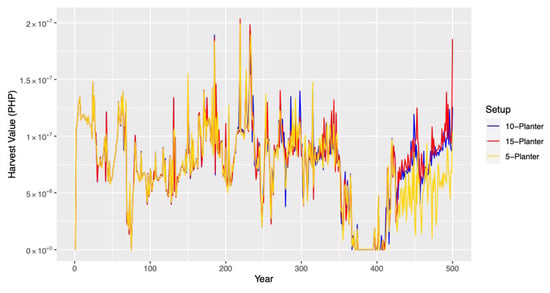
Figure 6.
Result of the 500-year simulation on three setups: 5-planter, 10-planter, and 15-planter.
The graph above shows that for the first 400 years, a harvest of equal value was generated by each setup. The number of planters utilized in a particular simulation experiment had an effect on the results only after 400 years. The average harvest gain shown in Figure 7 demonstrates that after 400 years, the value of the harvest obtained in setups with more planters is substantially larger than in setups with fewer planters.

Figure 7.
Average harvest value for simulation periods 1–400 and 401–500 on three setups: 5-planter, 10-planter, and 15-planter.
The interplay between the number of parcels ready to harvest (SL) and the number of parcels needing replanting (ANR) can be used to explain the significant impact of the number of planters on the value of the harvest. Figure 8 shows that towards the end of the 400-year simulation period, the number of SL parcels decreased close to zero, while the number of parcels requiring ANR sharply fluctuated. During this time, the forest had the opportunity to rest from harvesting activities and recover. After the 400th mark, replanting activities started to dominate even if there was a rise in the number of SL parcels. Due to the large trees which became available for harvest after the parcels had time to support tree growth, the value of the harvest increased.

Figure 8.
Comparison between the number of parcels candidate for SL and ANR activities in a 500-year simulation using default values (see Table 2).
Lastly, to understand how the parameters in the model contribute to the output, we subjected the model to the Sobol method, a variance-based sensitivity analysis. The Sobol method provides the most accurate and robust indices for associating the variance in the model output with individual parameters and their interactions [34]. The inputs that we were interested in were the number of harvester and planter agents, specifically the combination of 5–15 agents each. We observed the impact of the combination on four outputs of interest: the number of parcels for ANR, the number of parcels for SL, harvest value, and the total number of remaining trees (forest cover). We chose a sample size of 20 for the Sobol sequence and ran the model until the 500th simulation year.
The first-order index describes the effect of changing one input variable on the output variable, while the total-order index shows the relative importance of one input variable and its interaction with all other variables. For both indices, an index equal to 1 means that the input variable significantly affects the output variable, and an index equal to 0 means the contrary. Since we are only concerned with two input variables (i.e., the number of harvesters and the number of planters), we considered only the first-order index in the analysis of the model.
Figure 9 shows that the number of harvesters has a significant impact on the number of parcels ready for SL, while the number of planters has a significant impact on the number of parcels requiring ANR. This means that by changing only the number of harvesters, the capacity of the forest for SL also changes. Furthermore, by changing the number of planters, the need for ANR also changes. Interestingly, the figure also shows that the number of harvesters has a considerable influence on the change in demand for ANR, with a first-order index of 0.28, in contrast to the demand for SL, which is not influenced by the number of planters, with a first-order index of 0.03.
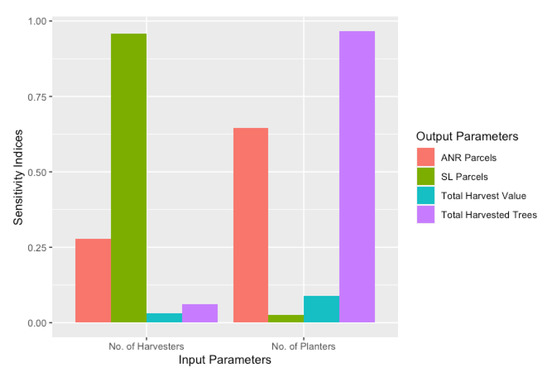
Figure 9.
First-order index result of the Sobol analysis on the effect of the number of harvesters and planters on four output values: ANR parcels, harvest profit, remaining trees, and SL parcels.
Regarding the impact of the input variables on the value of the harvest and the number of trees harvested, Figure 9 shows that it is the number of planters that has a significant impact on the number of trees harvested, while the total value of the harvest is not influenced by a single variable. The first-order index for the number of harvesters and the number of planters on the output parameter “Total Harvest Value” is less than 0.10, which means that the total value of harvest is not dependent on a single variable, but rather it is the dynamics between these variables that influence this output parameter.
3.2. Model Results
We performed three runs of the simulation with 500 simulation years each using the default variables (see Table 2). We tracked changes in the amount of overall harvest and in the forest cover, and we contrasted the outcomes of combining SL with ANR and SL without ANR.
Figure 10 shows that without ANR, there is a steady decline in the forest cover as a consequence of the continued harvesting without planting intervention. The initial number of trees will just continue to grow until they all get harvested after reaching the harvestable DBH. In contrast, with ANR, from the initial cover of 99,988 tree stands, forest cover decreased significantly by 20% in the first 100 years and could not recover but was able to maintain the same level until the end of the simulation. Note that at the beginning of the simulation, each parcel has an average of 390 trees, while the ANR plants only 300 trees per parcel at most (see Table 2). The 20% decrease in tree cover can be attributed to the ANR rules monitoring the parcels and ensuring that the harvested trees are replaced. This shows that with ANR, sustainable harvesting is possible even after 500 years of continuous SL activity.
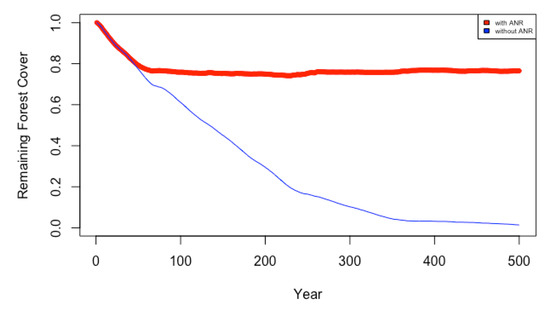
Figure 10.
Comparison between the effect of implementing and not implementing ANR in sustaining the forest cover.
Figure 11 shows that for the first 400 years, there was no discernible difference in the harvest value of SL operations with and without ANR, both averaging about PHP 7.7M. Only in the final 100 years of the simulation did the difference between performing ANR and not performing it became apparent. Additionally, the harvest value obtained over the course of the last 100 simulation years for the “with ANR” setup is PHP 6.8M on average, while the “without ANR” setup only made PHP 2.5M. This shows that for up to 500 years, SL operations with ANR can generate a profit that is sustainable.
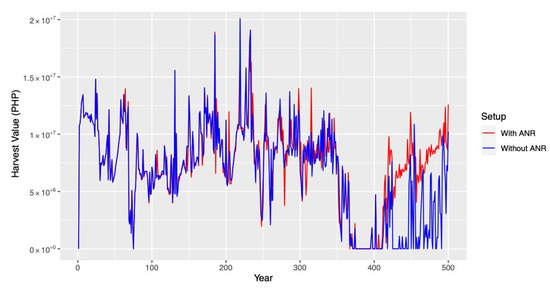
Figure 11.
Comparison between the effect of implementing and not implementing ANR with respect to the total harvest value.
Intriguingly, the simulation also demonstrated that, even after decades of continuous operations, the performance of selective logging on a healthy forest similar to the one employed in the model is nearly the same with and without ANR. The “with ANR” setup just began to exhibit a noticeably greater and more consistent harvest value than the “without ANR” setup in the final 100 years.
4. Conclusions
The model presented in this study showed that the ABM approach can be used as a tool to allow ex-situ testing of forest management regimes. Specifically, an ABM of forest operation on a theoretical forest was developed to inspect whether SL combined with ANR can lead to the profitable harvesting of timber resources while ensuring that the forest cover is sustainably maintained. The GAMA Forest Model has shown that it can predict future harvests with assumptions about growth and yield. Based on this, the model can also assess whether a forest has a sufficient harvest to make the investment feasible. The 500 simulation years were crucial to testing whether the trend revealed in the model is enough to generalize the sustainability of the operations. Simulation results revealed that regular ANR was successful in maintaining the forest cover at 80%, while SL activities were able to provide an average annual income of PHP 7.5 million over a significantly long time.
The model focused mainly on highlighting the supply-side opportunities for timber production rather than looking into the market equilibrium for timber products. Modeling both the supply and demand side is a challenge at this time given the existing moratorium on the cutting and harvesting of timber in the natural and residual forests through EO 23. In this context, the intention of the paper has been to provide a policy option in the form of sustainable forest harvesting operations where it is feasible to maintain forest cover while selective harvesting is also allowed. Once this first step has been put forward, and hopefully considered by policymakers, the role of population growth and demand in the wood/timber market can be integrated into future (and more comprehensive) models.
Finally, more important than the predictions that the GAMA Forest Model can provide is that the model can be used as a tool to understand the forest as a system and to identify the impacts of management regimes on it. The model has shown that with the right combination of reforestation efforts and timber harvesting methods, a sustainable forest operation can contribute to the country’s economic needs for timber production while ensuring that the forest is actively managed.
Author Contributions
Conceptualization, N.B.; data curation, L.B. and Z.A.; formal analysis, P.J.R. and Z.A., methodology, Z.A. and C.T.J.; supervision, N.B.; software, Z.A.; validation, Z.A.; visualization, Z.A., writing—original draft, Z.A. and P.J.R., writing—review & editing—Z.A., C.T.J., P.J.R., N.B., and L.B. All authors have read and agreed to the published version of the manuscript.
Funding
This research received no external funding.
Data Availability Statement
Data used in the generation of the theoretical forest was based on an unpublished dataset. Data sharing is not applicable to this article.
Acknowledgments
We would like to extend our sincerest gratitude to the workshop coordinators and facilitators of the 2020 Training Workshop on Modeling Using Geographic Information Systems (GIS) and Agent-based Modeling Applications (GAMA) held in SEARCA, Los Baños, Laguna.
Conflicts of Interest
The authors declare no conflict of interest.
Appendix A

Table A1.
Types of species considered as premium in the theoretical forest.
Table A1.
Types of species considered as premium in the theoretical forest.
| Family | Common Name | Scientific Name |
|---|---|---|
| Anacardiaceae | Dao | Dracontomelon dao |
| Apocynaceae | Lanete | Wrightia pubescens var. laniti |
| Dipterocarpaceae | Apitong | Dipterocarpus grandiflorus |
| Bagtikan | Parashorea malaanonan | |
| Dalingdingan | Hopea foxworthyi | |
| Guijo | Shorea guiso | |
| Hagakhak | Dipterocarpus validus | |
| Manggachapui | Hopea acuminata | |
| Mayapis | Shorea palosapis | |
| Palosapis | Anisoptera thurifera | |
| Saplungan | Hopea plagata | |
| While Lauan | Shorea contorta | |
| Ebenaceae | Ebony | Diospyros ferrea |
| Kamagong | Diospyros blancoi | |
| Fabaceae | Akle | Albizia acle |
| Banuyo | Wallaceodendron celebicum | |
| Ipil | Intsia bijuga | |
| Narra | Pterocarpus indicus | |
| Lamiaceae | Molave | Vitex parviflora |
| Meliaceae | Kalantas | Toona calantas |
References
- Chokkalingam, U. Center for International Forestry Research, Eds. One Century of Forest Rehabilitation in the Philippines: Approaches, Outcomes, and Lessons; Center for International Forestry Research: Bogor, Indonesia, 2006; ISBN 978-979-24-4643-2. [Google Scholar]
- Lasco, R.D.; Visco, R.G.; Pulhin, J.M. Secondary Forests in the Philippines: Formation and Transformation in the 20th Century. J. Trop. For. Sci. 2001, 13, 652–670. [Google Scholar]
- Philippine Forestry Statistics. Available online: https://forestry.denr.gov.ph/index.php/statistics/philippines-forestry-statistics (accessed on 5 February 2023).
- Forest Area (% of Land Area)—Philippines, World. Available online: https://data.worldbank.org/indicator/AG.LND.FRST.ZS?locations=PH-1W (accessed on 5 February 2023).
- Wood Summit: The Role of the Philippine Wood Industry in Nation Building. Available online: https://forestry.denr.gov.ph/index.php/wood-summit-the-role-of-philippine-wood-industry-in-nation-building (accessed on 4 January 2023).
- Office of the President of the Philippines [Benigno, S. Aquino, III]. Executive Order No. 23: Declaring a Moratorium on the Cutting and the Harvesting of Timber in the Natural and Residual Forests and Creating the Anti-Illegal Logging Task Force; Office of the President of the Philippines: Manila, Philippines, 2011. [Google Scholar]
- Paqueo, V.B.; Israel, D.C. Planting Seeds of Self-Defeat: Effects of Unrealistic Regulations on the Caraga Wood Industry and Forest Conservation; Philippine Institute for Development Studies: Quezon City, Philippines, 2016; Available online: http://hdl.handle.net/11540/9225 (accessed on 4 January 2023).
- Twery, M.J.; Weiskittel, A.R. Forest-Management Modelling. In Environmental Modelling; Wainwright, J., Mulligan, M., Eds.; John Wiley & Sons, Ltd.: Chichester, UK, 2013; pp. 379–398. ISBN 978-1-118-35147-5. [Google Scholar]
- Stenberg, L.C.; Siriwardana, M. Forest Conservation in the Philippines: An Economic Assessment of Selected Policy Responses Using a Computable General Equilibrium Model. For. Policy Econ. 2007, 9, 671–693. [Google Scholar] [CrossRef]
- Furtado, B.A.; Fuentes, M.A.; Tessone, C.J. Policy Modeling and Applications: State-of-the-Art and Perspectives. Complexity 2019, 2019, 5041681. [Google Scholar] [CrossRef]
- Bonabeau, E. Agent-Based Modeling: Methods and Techniques for Simulating Human Systems. Proc. Natl. Acad. Sci. USA 2002, 99, 7280–7287. [Google Scholar] [CrossRef] [PubMed]
- Osoba, O.A.; Vardavas, R.; Grana, J.; Zutshi, R.; Jaycocks, A. Modeling Agent Behaviors for Policy Analysis via Reinforcement Learning. In Proceedings of the 2020 19th IEEE International Conference on Machine Learning and Applications (ICMLA), Miami, FL, USA, 14–17 December 2020; pp. 213–219. [Google Scholar]
- Schulze, J.; Müller, B.; Groeneveld, J.; Grimm, V. Agent-Based Modelling of Social-Ecological Systems: Achievements, Challenges, and a Way Forward. JASSS 2017, 20, 8. [Google Scholar] [CrossRef]
- Taillandier, P.; Gaudou, B.; Grignard, A.; Huynh, Q.-N.; Marilleau, N.; Caillou, P.; Philippon, D.; Drogoul, A. Building, Composing and Experimenting Complex Spatial Models with the GAMA Platform. Geoinformatica 2019, 23, 299–322. [Google Scholar] [CrossRef]
- Kiruki, H.; van der Zanden, E.H.; Zagaria, C.; Verburg, P.H. Sustainable Woodland Management and Livelihood Options in a Charcoal Producing Region: An Agent-Based Modelling Approach. J. Environ. Manag. 2019, 248, 109245. [Google Scholar] [CrossRef] [PubMed]
- Lapp, M.; Long, C. A New Approach to Agent-Based Models of Community Resource Management Based on the Analysis of Cheating, Monitoring, and Sanctioning. Ecol. Model. 2022, 468, 109946. [Google Scholar] [CrossRef]
- Tew, R.D.; Straka, T.J.; Cushing, T.L. Forest Resource Management Planning: Why Plan? The Planning Process; FNR 110; Clemson (SC): Clemson Extension, Forestry and Natural Resources: Clemson, SC, USA, 2016; Available online: https://sref.info/resources/publications/forest-resource-management-planning-why-plan-the-planning-process (accessed on 4 January 2023).
- Alves, D.S.; Morton, D.C.; Batistella, M.; Roberts, D.A.; Souza, C. The Changing Rates and Patterns of Deforestation and Land Use in Brazilian Amazonia. In Geophysical Monograph Series; Keller, M., Bustamante, M., Gash, J., Silva Dias, P., Eds.; American Geophysical Union: Washington, DC, USA, 2009; Volume 186, pp. 11–23. ISBN 978-0-87590-476-4. [Google Scholar]
- Huang, X.; Li, S.; Su, J. Selective Logging Enhances Ecosystem Multifunctionality via Increase of Functional Diversity in a Pinus Yunnanensis Forest in Southwest China. For. Ecosyst. 2020, 7, 55. [Google Scholar] [CrossRef]
- Putz, F.E.; Romero, C.; Sist, P.; Schwartz, G.; Thompson, I.; Roopsind, A.; Ruslandi, R.; Medjibe, V.; Ellis, P. Sustained Timber Yield Claims, Considerations, and Tradeoffs for Selectively Logged Forests. Proc. Natl. Acad. Sci. USA Nexus 2022, 1, 102. [Google Scholar] [CrossRef]
- Chazdon, R.L.; Brancalion, P.H.S.; Lamb, D.; Laestadius, L.; Calmon, M.; Kumar, C. A Policy-Driven Knowledge Agenda for Global Forest and Landscape Restoration. Conserv. Lett. 2017, 10, 125–132. [Google Scholar] [CrossRef]
- Carandang, W.M.; Paelmo, R.F.; Lee, D.K.; Carandang, V.Q. Assisted Natural Regeneration as Affected by Lodging and Slashing Vegetation in a Grassland in the Philippines. For. Sci. Technol. 2007, 3, 47–52. [Google Scholar] [CrossRef]
- FAO. Restoring Forest Landscapes through Assisted Natural Regeneration (ANR)—A Practical Manual; Food and Agriculture Organization: Bangkok, Thailand, 2019; 52p. [Google Scholar]
- Dugan, P. Advancing Assisted Natural Regeneration (ANR) in Asia and the Pacific; Food and Agriculture Organization of the United Nations, Regional Office for Asia and the Pacific: Bangkok, Thailand, 2003; ISBN 978-974-7946-49-9. [Google Scholar]
- Grimm, V.; Berger, U.; Bastiansen, F.; Eliassen, S.; Ginot, V.; Giske, J.; Goss-Custard, J.; Grand, T.; Heinz, S.K.; Huse, G.; et al. A Standard Protocol for Describing Individual-Based and Agent-Based Models. Ecol. Model. 2006, 198, 115–126. [Google Scholar] [CrossRef]
- Grimm, V.; Berger, U.; DeAngelis, D.L.; Polhill, J.G.; Giske, J.; Railsback, S.F. The ODD Protocol: A Review and First Update. Ecol. Model. 2010, 221, 2760–2768. [Google Scholar] [CrossRef]
- Nguyen, T.T. Modelling Growth and Yield of Dipterocarp Forests in Central Highlands of Vietnam. Ph.D. Dissertation, Technische Universität München, München, Germany, 8 March 2010. [Google Scholar]
- FMB (Forest Management Bureau). FMB Technical Bulletin No. 3: Measurement Standards and Procedures in the Conduct of Inventory for Standing Trees (Timber); Forest Management Bureau: Manila, Philippines, 2014. [Google Scholar]
- Johnson, S.E.; Abrams, M.D. Basal area increment trends across age classes for two long-lived tree species in the eastern US. In TRACE—Tree Rings in Archaeology, Climatology, and Ecology; Scientific Technical Report STR, 09/03, Kaczka, R., Malik, I., Owczarek, P., Gartner, H., Helle, G., Heinrich, I., Eds.; GFZ: Potsdam, Germany, 2009. [Google Scholar]
- Russell, M.B.; Weiskittel, A.R.; Kershaw, J.A. Comparing Strategies for Modeling Individual-Tree Height and Height-to-Crown Base Increment in Mixed-Species Acadian Forests of Northeastern North America. Eur. J. Forest. Res. 2014, 133, 1121–1135. [Google Scholar] [CrossRef]
- Mangaoang, E.O. Annex 8: Economic analysis of community-based timber harvesting. In Management of Resources on Forestlands through Enhanced Sustainable Technologies; GIZ EnRD Program Philippines, CBFM Component: Manila, Philippines, 2013. [Google Scholar]
- DENR (Department of Environment and Natural Resources). Annual Allowable Cut Computation and Tree Marking Goal Determination in the Second Growth Dipterocarp Forest; Administrative Order No. 12; Department of Environment and Natural Resources: Quezon City, Philippines, 1992. Available online: https://apidb.denr.gov.ph/infores/uploads/policy/1992/FOR_DAO_1992_12.pdf (accessed on 4 January 2023).
- Taillandier, P.; Grignard, A.; Marilleau, N.; Philippon, D.; Huynh, Q.-N.; Gaudou, B.; Drogoul, A. Participatory Modeling and Simulation with the GAMA Platform. JASSS 2019, 22, 3. [Google Scholar] [CrossRef]
- Herman, J.D.; Kollat, J.B.; Reed, P.M.; Wagener, T. Technical Note: Method of Morris Effectively Reduces the Computational Demands of Global Sensitivity Analysis for Distributed Watershed Models. Hydrol. Earth Syst. Sci. 2013, 17, 2893–2903. [Google Scholar] [CrossRef]
Disclaimer/Publisher’s Note: The statements, opinions and data contained in all publications are solely those of the individual author(s) and contributor(s) and not of MDPI and/or the editor(s). MDPI and/or the editor(s) disclaim responsibility for any injury to people or property resulting from any ideas, methods, instructions or products referred to in the content. |
© 2023 by the authors. Licensee MDPI, Basel, Switzerland. This article is an open access article distributed under the terms and conditions of the Creative Commons Attribution (CC BY) license (https://creativecommons.org/licenses/by/4.0/).